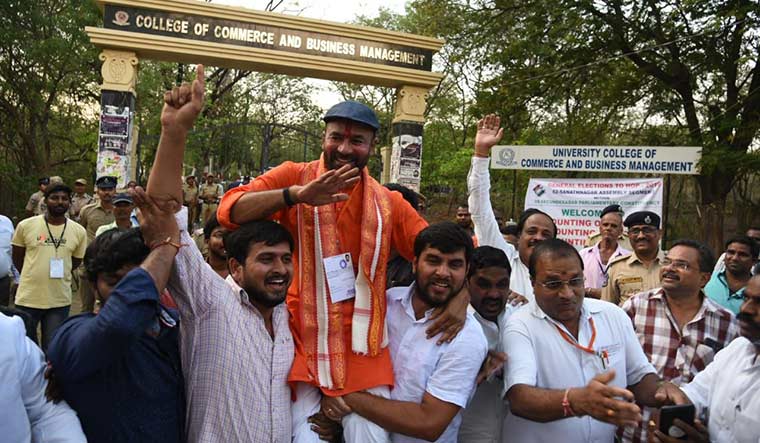Has the Modi wave changed the colour and character of north Telangana? It seems so. Three of the four Lok Sabha seats the BJP won—Karimnagar, Adilabad and Nizamabad—fall in north Telangana and were once hotbeds of Maoist activity. Top Maoist leaders, including Kishenji and Ganapathy, hail from villages around Karimnagar town. The town is also home to intellectuals sympathetic to the cause. However, notably, the top issue during the recent elections here was the Hindu-Muslim divide. Many youth rallied behind BJP candidate Bandi Sanjay Kumar after social media posts of an attack on him—allegedly by All India Majlis-e-Ittehadul Muslimeen supporters—went viral. On March 29, Chief Minister K. Chandrashekar Rao had said in a public meeting that he was more Hindu than Prime Minister Narendra Modi. This was taken out of context and was converted into a campaign tool. “He has become very close to [AIMIM president Asaduddin] Owaisi,” said a voter in Karimnagar. “This is the reason he was taught a lesson. As it was a matter of self-respect for Hindus, we voted for Modi.” Rao’s closest aide Vinod Kumar Boianapalli, former deputy leader of the Telangana Rashtra Samithi in the Lok Sabha, lost Karimnagar by a margin of almost 90,000 votes.
Last December, in the assembly elections, the BJP’s vote share was 7.1 per cent. In the Lok Sabha elections, it was 19.45 per cent. Even the party was surprised with the performance. According to its internal assessment, a major factor was Modi’s image. Additionally, the BJP gained strength in constituencies with more Muslims, or in seats where the AIMIM had a presence. Said BJP national general secretary P. Muralidhar Rao: “In Telangana, there is a legacy of fighting the Razakars (a private militia), who belonged to the Nizams. This legacy can be owned by the BJP. This was an important freedom movement and, apart from the BJP, no other party has respected it. How are people going to forget it? The BJP’s growth should be a reality in one to two years.”
Th recent success has emboldened the BJP to pursue its goal of making Telangana a “second gateway” to south India, after Karnataka.
“In some constituencies, the BJP candidates did not campaign and nobody even knew their names,” said a senior Congress leader, on condition of anonymity. “Even then, lakhs of votes were polled in their favour. This shows the power of Modi.”
Rao’s daughter, K. Kavitha, who recently won the best parliamentarian award, lost to BJP candidate Arvind Dharmapuri in Nizamabad. Here, the local BJP leaders wooed sections of backward communities and the land-owning Reddys. The youth also supported the BJP. Apparently, some local Congress and TRS leaders also worked for the BJP’s victory, because of caste factors and resentment against the TRS.
In Adilabad, the divide between the local adivasis and the Lambadas, both scheduled tribes, over sharing of government benefits, helped the BJP. While parties have usually been shy of taking sides, the BJP had fielded an adivasi candidate.
Interestingly, in the four seats that the BJP won, the Congress was a non-factor. Its candidates were almost invisible on ground. In Secunderabad, from where Minister of State for Home G. Kishan Reddy won, the Congress candidate Anjan Kumar Yadav, a two-time MP, looked like he was not even in the fray. This prompted the TRS to suspect a tacit understanding between the Congress and the BJP.
Not long ago, the BJP and the TRS were accused of having a secret alliance. The TRS, which was hoping to sweep the state and prop up Rao as the prime minister face of a separate federal front, won only 9 of the 17 seats. And though still in power, the party is in a vulnerable position. In the last four years, the TRS did everything possible to weaken the main opposition party, the Congress, while the BJP reaped the benefits. This was also the time when the Modi-Rao bonhomie apparently peaked. The TRS “poached” several top Congress leaders, leaving the party a shambles. But the TRS, perhaps, did not sense the BJP’s game plan.
Now, an upbeat state BJP, aided by bosses in Delhi, is gearing up for a showdown with the TRS, and has a well laid-out strategy for the next few years. “Our president Amit Shah is particular that we become a strong force in this state,” said state party president K. Laxman. “We are an alternative to the TRS as people have lost faith in the party because of its arrogance. The Congress leaders have vested interests because of their financial dealings and everyone knows they have been compromised.”
The next big step for the BJP is to bring in big names and popular leaders, and start an aggressive campaign. The party has already hinted that some surprises in the next few months will rattle their opponents.
“We will act as the main opposition party now,” said BJP strategist Muralidhar Rao. Laxman was more optimistic. “We will occupy the chief minister’s chair in 2023,” he said.
Political analysts, however, say it would not be a cakewalk. “The BJP was the choice of the voters in the national elections,” said senior political analyst and former MLC K. Nageshwar. “The results do not indicate the growth of the BJP and only show the mood of the voter. These results may not be replicated in the assembly elections. Looking at the BJP’s priorities, it looks like it is still not serious about south India. Despite winning four seats in Telangana, the party did not give a cabinet post to any of the four MPs.”



